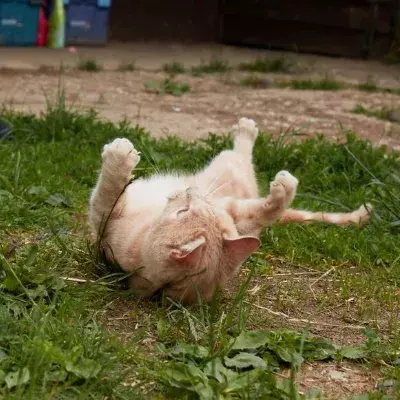Every cat is an individual, so when interacting with them it's important to figure out what they like or dislike and then respect their preferences
Some cats will happily spend hours on your lap
Others will prefer to just be close by
And some may prefer playing with toys rather than being petted
At Battersea, we use the acronym C A T to understand what kind of interaction a cat is comfortable with
It stands for "choice"
Did I give the cat a choice to tell me if they actually wanted to be touched, where they wanted to be touched, and when they had had enough
"Am I paying attention"
Am I looking out for any signs that tell me the cat is enjoying the interaction or might be uncomfortable
"Touch"
Where am I touching the cat
Is this a place friendly cats generally like being touched
For touch, think of a traffic light system
Green areas are the places where cats generally like to be touched and include the cheeks, base of the ears, and the chin
Red areas are very sensitive for most cats
These are the stomach and the base of the tail
The rest of a cat's body are amber areas, which some cats might like having touched but many won't
Red and amber areas should generally be avoided especially if you don't know the cat well
The CAT acronym can be used with any cat and will help to keep interactions positive
Now let's apply it to some different situations
First, crouch down a little distance away from the cat and offer them your hand
A cat who wants to interact will come over to you and probably rub their cheek on your hands
This is a good sign - they want to be touched
Try to let the cat take charge and only touch the areas they have chosen to rub against you
Usually the cheeks and around the base of their ears
After a few seconds gently move your hand away
This gives the cat the choice of going in for more or moving away
Offering breaks will help gain their trust and help them feel in control
Even if you think they're enjoying the interaction it's important to check in regularly with how the cat is feeling
Pay attention and always adjust your approach based on the cat's body language
Some cats will enjoy sitting near people but without any physical contact
If a cat sits slightly away from you it's important not to force them to interact
You could try offering a hand from where you're sitting but if they don't approach you then leave them to it
When a cat doesn't want to be touched they will show you in lots of ways
The cat might move away, stop purring or rubbing against you, suddenly stop moving, yawn and turn their head away, lick their nose, shake their head, rotate or flatten their ears, ripple their fur if you try to touch them
These are all subtle signs that the cat is not comfortable and needs some space
It's also important to remember that most cats don't like to be picked up as this takes away their choice and control entirely
Now that you've learned CAT remember: always give your cat the choice to interact while paying attention to their body language and only stroking them where they're comfortable being touched
That was our advice on interacting with your cat The Battersea Way
For more hints and tips visit the Battersea website and follow our channels
